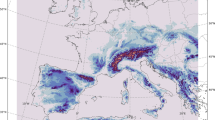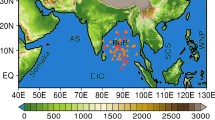Summary
Results of an earlier study of cyclone track prediction using a quasi-Lagrangian model (QLM) to generate track forecasts of up to 36 hours were reported by Prasad and Rama Rao (2003). Further experiments to produce track forecasts of up to 72 hours with an updated version of the same model have been carried out in the present study. In this case, the ability of the model to predict recent historical cyclones in the Bay of Bengal and Arabian Sea has been assessed. Analysis of some of the structural features of analyzed and predicted fields has been carried out. Such fields include wind distribution and vertical motion around the cyclone centre. In addition, the merging of an idealized vortex with the large scale initial fields provided by a global model, has been carried out for a particular case study of a May 1997 storm, which hit the Bangladesh coast. This current study has demonstrated that the model generates a realistic structure of a tropical cyclone with an idealized vortex. Performance evaluation has been carried out by computing the direct position errors (DPE). The results of which show that the mean error for a 24 h forecast is about 122 km, which increases to about 256 km for a 48 h forecast and 286 km for a 72 h forecast. These figures are comparable to similar errors in respect of tropical cyclone forecasts produced by an advanced NWP centre, viz., the UKMO global model during the corresponding period, 1997–2000 (obtained from UKMO web site). The average forecast errors of the UKMO model are 160 km for 24 h, 265 km for 48 h, 415 km for 72 h forecast ranges.
Similar content being viewed by others
References
WM Frank (1977) ArticleTitleThe structure and the energetics of the tropical cyclone I: Storm sstructure. Mon Wea Rev 105 1119–1135
WM Gray DJ Shea (1973) ArticleTitleThe hurricane’s inner core region, II. Thermal stability and dynamic characteristics. J Atmos Sci 30 1565–1576 Occurrence Handle10.1175/1520-0469(1973)030<1565:THICRI>2.0.CO;2
SJ Lord JE Franklin (1987) ArticleTitleThe environment of hurricane Debby (1982), part I: Winds. Mon Wea Rev 115 2760–2780
MB Mathur (1991) ArticleTitleThe National Meteorological Centre’s quasi-Lagrangian model for hurricane prediction. Mon Wea Rev 119 1419–1447
MB Mathur J Ruess (1993) ArticleTitleFurther evaluation of the quasi-Lagrangian model’s forecast track guidance. Mon Wea Rev 121 1514–1530 Occurrence Handle10.1175/1520-0493(1993)121<1514:FEOTQL>2.0.CO;2
K Prasad YV Rama Rao (2003) ArticleTitleCyclone track prediction by a quasi-Lagrangian model. Meteorol Atmos Phys 83 173–185
HE Willoughby (1990) ArticleTitleTemporal changes of the primary circulation in tropical cyclones. J Atmos Sci 47 242–264
Author information
Authors and Affiliations
Rights and permissions
About this article
Cite this article
Prasad, K. Further experiments on cyclone track prediction with a quasi-Lagrangian limited area model. Meteorol. Atmos. Phys. 91, 183–199 (2006). https://doi.org/10.1007/s00703-004-0103-x
Received:
Revised:
Accepted:
Published:
Issue Date:
DOI: https://doi.org/10.1007/s00703-004-0103-x




